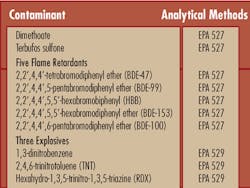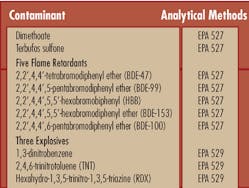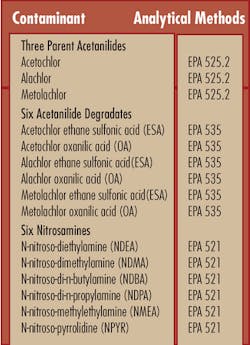The U.S. Environmental Protection Agency recently approved an experimental program to allow the city of Los Angeles to inject treated sewage sludge nearly a mile below the ground in a sandstone formation beneath its Terminal Island Treatment Plant in San Pedro, CA.
The permit allows the city, over a five-year period, to pump up to 400 tons of treated sewage sludge per day into the depleted oil field to evaluate potential benefits of using fracture injection technology. The potential benefits of this experiment include safety of disposal, generating significant quantities of methane for future energy use and permanent carbon dioxide sequestration. This project will not affect drinking water supplies.
Work is expected to begin early in 2007.
This experimental permit allows the city of Los Angeles to pursue an alternative to its current practice of applying its treated sewage sludge to agricultural fields in Kern County.
The injection project is said to be the first of its kind. While oil companies have long disposed of oil field waste by injection drilling, this will mark the first time that treated human waste will be pumped so far below ground.
According to an LA Times article, the sludge will be mixed with treated wastewater to produce a slurry that will seep into porous sandstone and decompose, producing methane gas and carbon dioxide. The methane would be extracted to produce energy for the sewage treatment plant on Terminal Island and the carbon dioxide would remain sequestered below ground, reducing emissions of a greenhouse gas.
The city will drill three wells -- one for injecting the sludge and the other two to monitor the effectiveness of the project. While deep-well injections can pose a threat to groundwater, the sludge would be injected at least half a mile below the nearest water table - and that region is contaminated with saltwater.
Los Angeles sewage treatment plants produce about 730 tons a day of sludge, with the majority being trucked to the city’s Green Acres farm 15 miles southwest of Bakersfield. Last year voters in Kern County approved a ballot measure that banned the sludge dumping. While the ban was blocked by the courts and land application continues, Los Angeles is attempting to develop other options for sludge disposal.
If successful, the process could be used in depleted oil fields anywhere, proponents said.
“For many years, we’ve been putting too many eggs in one basket and it’s ultimately our intent to diversify our program to the best we can,” Omar Moghaddam, regulatory affairs manager for the city’s public works department, was quoted as saying by the LA Times.
The methane could produce enough energy to power 3,500 homes, while the carbon sequestration would cut carbon emissions by 81,000 tons a year, he said.
EPA sent its response to those who commented on the draft permit, and also posted the responses, along with the final permit itself, on its Web site at: http://www.epa.gov/region09/water/groundwater/uic-permits.html#la.
EPA Publishes Unregulated Contaminant Monitoring Rule
The recently published Unregulated Contaminant Monitoring Rule (UCMR 2) will require about 4,000 public water systems to monitor drinking water for up to 25 unregulated chemicals to help the Environmental Protection Agency understand the frequency and levels at which the contaminants are found in US drinking water systems.
EPA will use the data to determine whether regulations are needed to protect public health. EPA currently has regulations for more than 90 contaminants. The Safe Drinking Water Act requires EPA to identify up to 30 contaminants for monitoring every five years.
The first cycle, UCMR 1, was published in 1999 and covered 25 chemicals and one microorganism. The new rule requires systems to monitor for contaminants that are not regulated under existing law.
Contaminants on the list include five flame retardants, three explosives, pesticides, herbicides and suspected carcinogens.
EPA selected the contaminants that will be monitored after reviewing its own contaminant candidate list and other contaminants cited in current research about occurrence and health-risk factors. Pesticides that were not registered for use in the United States, contaminants that did not have an analytical reference standard, and contaminants whose analytical methods were not ready for use were removed from the list. EPA further prioritized the remaining contaminants based on more extensive health effects evaluations by the Office of Water’s Office of Science and Technology.
Under the rule, all Public Water Systems (PWSs) serving more than 10,000 people, and 800 representative systems serving less than 10,001 people are required to monitor for the 10 “List 1” contaminants during a 12-month period between January 2008-December 2010. In addition, all systems serving more than 100,000 people, 320 representative PWSs serving 10,001-100,000 people, and 480 representative systems serving less than 10,001 people are required to monitor for the 15 “List 2” contaminants during a 12-month period between January 2008-December 2010.
Similar to Unregulated Contaminant Monitoring Regulation 1 (UCMR 1) reporting, laboratories responsible for sample analysis will post data, and PWSs will review and act upon data, through the Safe Drinking Water Accession and Review System (SDWARS). Users access SDWARS through the Central Data Exchange (CDX), EPA’s electronic reporting system.
Public water systems (PWSs) that are subject to UCMR 2 need to be aware of the requirements of the Consumer Confidence Report (CCR) Rule and the Public Notification (PN) Rule. The CCR rule requires that community water systems report monitoring results when unregulated contaminants are detected. The PN rule also requires that systems notify the public that the results are available.
The UCMR benefits the environment and public health by providing EPA and other interested parties with scientifically valid data on the occurrence of the contaminants in drinking water, the population being exposed and the levels of that exposure. The information is the primary source of exposure data for the Agency uses when deciding whether to regulate contaminants.
EPA estimates the 5-year UCMR 2 will cost $44.3 million. EPA will conduct and pay for the monitoring for those water systems serving 10,000 people or fewer at a cost of $9 million.
Laboratories interested in analyzing samples for PWSs subject to the UCMR 2 monitoring requirements need to register for the EPA Laboratory Approval Program. Laboratories need to complete and submit the method-specific application packages. Upon a complete review, qualified laboratories will become eligible to participate in a Proficiency Testing (PT) Program. Laboratories that successfully complete the PT Program will be granted method-specific approval.
Additional information may be found on the EPA website at: http://www.epa.gov/safewater/ucmr/ucmr2/.
Incentives Proposed for Clean Water Permit Fees
A proposed EPA rule would provide a financial incentive to states to use fees when running a clean water permit program. EPA’s rule would allot up to three percent of state water pollution control grant funds to states that have adequate National Pollutant Discharge Elimination System (NPDES) permit fee programs.
“We encourage states to use permit fees for additional funding for their clean water programs,” said EPA Assistant Administrator of Water Benjamin H. Grumbles. “A variety of tools and funding approaches are needed for a strong program, including having permitted facilities share the cost of keeping water clean.”
The increased cost of administering water permit programs has prompted some states to levy permit fees to cover shortfalls. Certain states, however, still operate with little or no reliance on permit fees. The proposed NPDES Permit Fee Incentive for Clean Water Act Section 106 Grants; Allotment Formula is designed to create financial incentives to prompt more states to implement adequate fee programs and shift part of the financial burden to those who benefit from the permits. It will also allow states to move funds to other critical water quality program activities.
The proposed rule would not take effect until after Oct. 1, 2008. The proposed rulemaking includes a 60 day public comment period.
EPA Finalizes 2006 Effluent Guidelines Plan
EPA’s Effluent Guidelines Plan for 2006 does not include any major revisions to effluent guidelines. EPA does, however, intend to conduct more focused reviews in 2007 and 2008 for a select number of industrial sectors as part of the 2008 Plan.
EPA publishes an Effluent Guidelines Program Plan every other year, as required by the Clean Water Act. EPA published the preliminary 2006 Plan for public comment on August 29, 2005. The Agency received 61 comments from a variety of commenters.
After reviewing additional data and public comments on the preliminary effluent guideline plan, EPA has decided to conduct focused reviews of four industrial sectors: Steam Electric Power Generating, Coal Mining, Coalbed Methane Extraction, and Health Services including emerging pollutants such as pharmaceuticals.
“EPA’s effluent guidelines plan includes a comprehensive review of technology-based controls and a strategic roadmap for responding to data needs and emerging contaminants,” said Benjamin H. Grumbles, Assistant Administrator for Water.
Effluent guidelines are industry specific national regulations that control the discharge of pollutants to surface waters and to publicly owned treatment works. EPA has issued effluent guidelines for 56 industries that prevent the discharge of more than 1.2 billion pounds of toxic pollutants each year.
Based on the 2004 Effluent Guidelines Plan, EPA is currently studying whether guidelines are needed for discharges from drinking water treatment facilities.
To read the federal notice visit: http://www.epa.gov/guide/plan.html.





